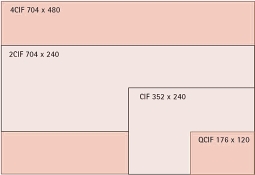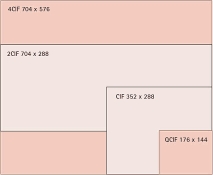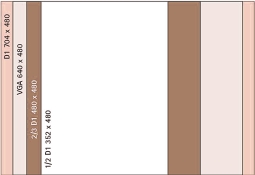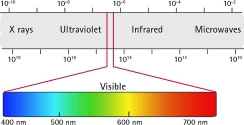
Resolution has a similar significance in the analog and digital worlds, but there are some important differences in how it is defined: in analog video the image consists of lines, or TV-lines, since analog video technology is derived from the television industry. In a digital system the picture is made up of pixels (picture elements).
NTSC and PAL resolutions
In North America and Japan, the NTSC standard (National Television System Committee) is the dominant analog video standard, while in Europe the PAL standard (Phase Alternation by Line) is used. Both originate from the television industry. NTSC has a resolution of 480 horizontal lines, and a frame rate of 30 fps. PAL has a higher resolution with 576 horizontal lines, but a lower frame rate of 25 fps. The total amount of information per second is the same in both standards.
When analog video is digitised, the maximum number of pixels that can be created is based on the number of TV lines available to be digitised. In NTSC the maximum size of the digitised image is 704x480 pixels. In PAL it is 704x576 pixels. In most analog security applications only a quarter of the analog picture is used, based on quads making four cameras share the maximum resolution. This quarter of the total image size has become known as CIF (Common Intermediate Format) in the video surveillance industry.
In NTSC, CIF means 352x240 pixels and in PAL 352x288 pixels. 2CIF resolution is 704x240 (NTSC) or 704x288 (PAL) pixels, which means dividing the number of horizontal lines by two. In most cases, each horizontal line is shown twice, so called 'line doubling', when shown on a monitor in order to maintain correct ratios in the image. This is a way to cope with motion blur in interlace scan. Sometimes a quarter of the CIF image is used, called QCIF, short for Quarter CIF.


VGA resolution
With the introduction of network cameras, completely digital systems can be designed. This makes the limitations of NTSC and PAL irrelevant. Several new resolutions derived from the computer industry have been introduced, providing better flexibility, and moreover they are worldwide standards. VGA is defined as 640x480 pixels, a similar size to NTSC and PAL. VGA resolution is normally better suited for network cameras since the video in most cases will be shown on computer screens, with resolutions in VGA or multiples of VGA.
Quarter VGA (QVGA) at 320x240 pixels is also commonly used, similar to CIF. QVGA is sometimes called SIF (Standard Interchange Format) resolution, easily confused with CIF. Other VGA-based resolutions are XVGA (1024x768 pixels), and 1280x960 pixels, 4 times VGA, providing megapixel resolution. (See below)
MPEG resolution
MPEG resolution usually means one of the following resolutions:
* 704x576 pixels (TV PAL).
* 704x480 pixels (TV NTSC).
* 720x576 pixels (DVD-Video PAL).
* 720x480 pixels (DVD-Video NTSC).

Megapixel resolution
The higher the resolution, the more detail can be seen in an image. This is a very important consideration in video surveillance applications, where a high-resolution image can enable a criminal to be identified. The maximum resolution in NTSC and PAL, after the video signal has been digitised in a DVR or a video server, is 400 000 pixels (704x576 = 405 504), or about 0,4 Megapixel. Using the CIF format, ie, a quarter of the image, the resolution is down to a mere 0,1 Megapixel.
Even though the video surveillance industry has always managed to live with these limitations, new network camera technology now makes higher resolution possible. A common megapixel format is 1280x1024, giving 1,3 megapixel resolution, 13 times higher than a CIF image. Cameras with 2 megapixel and 3 megapixel are also available, and even higher resolutions are expected in the future.
Megapixel network cameras also bring the benefit of different aspect ratios. In a standard TV an aspect ratio of 4:3 is used, while movies and wide-screen TV use 16:9. The advantage of this aspect ratio is that, in most images, the upper part and the lower part of the picture are of no interest, yet they take up precious pixels, and therefore bandwidth and storage space. In a network camera any aspect ratio can be used. In addition, digital pan/tilt/zoom can be achieved, where the operator selects which part of the megapixel images should be shown. This does not imply any mechanical movement from the camera. It ensures much higher reliability and makes it possible for different operators to pan and tilt to different areas of the image simultaneously.

Illumination: day and night use
In low-light conditions infrared (IR) cameras are particularly useful. Infrared-sensitive cameras, which make use of invisible IR light, can be applied, for instance, in a residential area late at night without disturbing residents, or when the cameras should not be evident.
Light is a form of radiant energy that covers a spectrum, of which the human eye can see only a portion (between wavelengths of ~400-700 nanometres or nm). Below blue is ultraviolet light, and above red is infrared light. IR is emitted by all objects: warmer objects such as people and animals stand out from typically cooler backgrounds. In low light conditions, for example at night, the human eye cannot perceive colour and hue - only black, white and shades of grey.

A colour camera's image sensor can detect a wider spectrum, including IR. Allowing IR to hit the image sensor during daylight, however, will distort colours so colour cameras are equipped with an IR-cut filter to remove IR light.
As illumination is reduced a good day/night camera will automatically remove the IR-cut filter, and will typically switch to black and white mode, giving clear images even in a very dark environment. Some will also allow manual control of IR-cut.
For more information contact Roy Alves, Axis Africa, 011 548 6780, [email protected]

© Technews Publishing (Pty) Ltd. | All Rights Reserved.